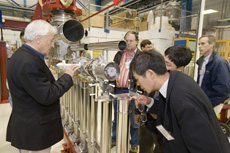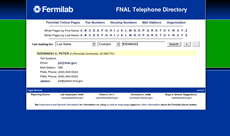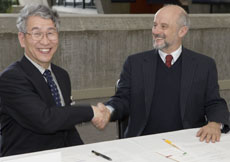|
Tue., May 1
3:30 p.m.
DIRECTOR'S COFFEE BREAK - 2nd Flr X-Over
THERE WILL BE NO ACCELERATOR PHYSICS AND TECHNOLOGY
SEMINAR TODAY
Wed., May 2
THERE WILL BE NO FERMILAB ILC R&D MEETING THIS WEEK
3:30 p.m.
DIRECTOR'S COFFEE BREAK - 2nd Flr X-Over
4:00 p.m.
Fermilab Colloquium
1 West
Speaker: C. Laughton, Fermilab
Title: Going Deep...Putting the Underground Dimension to Use
Announcement
Real Time Computing 2007 will be held at Fermilab on April 29 - May 4, 2007
Click here for more information.
Click here for NALCAL,
a weekly calendar with links to additional information. |
Tuesday, May 1
-Golden broccoli & cheese
-Cheesy Greek squeeze
-Coconut crusted tilapia
-Spaghetti w/ meatballs
-Smart Cuisine: Toasted almond chicken salad on croissant
-Assorted pizza slices
-Chicken fajitas
Wilson Hall Cafe Menu |
|
Wednesday, May 2
Lunch
- Calzone w/ sausage
- Roasted red peppers and 3 cheeses
- Romaine w/ cherry tomatoes & red onion
- Mocha cake
Thursday, May 3
- Tortilla chicken soup
- Halibut Veracruz
- Chipotle mashed potatoes
- Vegetable of the season
- Profiteroles stuffed w/ fruit
Chez Leon Menu
Call x4598 to make your reservation. |
|
|
TESLA Tech Collaboration tests new recipes at Fermilab

During a tour of Fermilab's new ILC facilities, participants in the TESLA meeting
visited the Cryomodule Assembly Building.
Last week, more than 100 scientists from around the world met at Fermilab to discuss recipes for baking, rinsing and polishing -- but not the kinds of recipes used for baking a cake. Instead, attendees at the TESLA Technology Collaboration shared information about developing the optimal recipe for pushing forward superconducting radiofrequency, or SCRF, technolgy.
As the chosen technology for the International Linear Collider, the SCRF cavity is a hot (or cold) topic for hundreds of scientists who are contributing to R&D for the proposed electron-positron accelerator. On a larger scale, the mission of the TTC is to advance SCRF technology and related accelerator studies across the broad spectrum of scientific applications, providing a forum for the world's experts to share ideas, developments and tests. "The ILC is a big component right now, but there are many other applications for this technology," said Cornell University's Maury Tigner, chair of the TTC.
The meeting at Fermilab marked the fourth TTC workshop, originally established in 2004 in response to the decision to use SCRF technology for the ILC. At a time when new advancements in SCRF technology are occurring weekly, the meeting allowed experts to ask questions and seek out advice for producing the optimal superconducting cavity. "In recent weeks, we achieved an accelerating gradient of 59 megavolts per meter, which exceeds the initial expected capabilities for this technology," Tigner said. "This is wonderful, but there is a real concern about the variations in performance from one cavity to the next."
Superconducting cavity recipes aren't simple. The tiniest piece of dust inside a cavity can impact how efficiently it can accelerate particles, and getting the cavities sparkling clean is a complicated process. Laboratories and universities throughout the world have each developed their own cavity recipes, making it difficult to determine the best process. In order to overcome this hurdle, members of the TTC are developing one specific recipe for all labs to use. "We need more testing to get more data before we will know if this recipe works," said John Mammosser of Jefferson Laboratory, during the TTC meeting. "We need to make sure to stick with this one recipe and not change it until we understand its performance." Mammosser hopes to have enough data to evaluate this recipe by the next TTC meeting.
In between discussions on simplifying the process for treating superconducting cavities, meeting attendees toured Fermilab's ILC test facilities. Attendees visited the lab's brand new horizontal test stand and a functioning cryomodule assembly building, just a few of the highlights of Fermilab facilities that will be used by collaborators around the world.
For more information on the meeting talks, visit the TTC meeting web site.
-- Elizabeth Clements
|
'Number, please:' Dial up new phone listings on Wednesday

On Wednesday morning, those searching for a Fermilab employee through the telephone directory will no longer see the familiar old blue and white page. May 2 marks the changeover to a new telephone directory system, which promises to simplify and speed up searches.
The new telephone directory system will mark the first change in the Fermilab online telephone directory in more than six years. More search functions will simplify finding contacts. Instead of searching for a single string in a single field, such as someone's last name, the new system allows simultaneous searches for up to three strings. You can now search for someone by entering the last name, first name and department. The system also features a more accurate "sounds like" option. More information will be listed in each search result, including public addresses (if allowed by the employee) and Jabber IM account information.
The new page will be in place Wednesday morning, but if anyone needs additional transition time, a link to the old page will be available for a few weeks. Notably, URL links from the old system on the web, and command line searches, will continue to work with the new directory.
-- Rhianna Wisniewski
|
From msnbc, April 30, 2007
Timeline for particle collider in doubt
Possible delays are in part a result of magnet failure in 17-mile tunnel
GENEVA - The world's most ambitious particle collider - which scientists hope could reveal what matter is made of - might not be fully functional until next year, months after its scheduled startup date, officials at the European Organization for Nuclear Research said Thursday.
Read more
|
|
|
Collaborating with KEK

KEK director Atsuto Suzuki and Fermilab director Pier Oddone signed an MOU last week, formalizing collaboration between the labs.
Last Monday and Tuesday we hosted a delegation from KEK led by Professor Atsuto Suzuki, the director of KEK. This visit was reciprocal to the visit by a Fermilab team to KEK and JPARC last Fall. During the visit last week Professor Suzuki and I signed a memorandum of understanding between KEK and Fermilab setting forward our intent to collaborate across a broad physics front and describing the framework under which we would do so.
As we move forward in the development of programs that are increasingly global, the relations we will develop with major laboratories across the world will be ever closer and interdependent. We have common interests with KEK in the energy frontier with the Tevatron and the LHC, in the development of the ILC and in the development of a global neutrino program. In all these areas we share our enthusiasm for physics and we collaborate to open up opportunities.
In the case of the ILC, the first priority for both Fermilab and KEK is to make it possible for the ILC to be built somewhere by collaborating in the R&D and the engineering design. We fully understand that down the line we are likely to compete to be the host for the ILC, something that will be settled at higher levels of government. We both will be fortunate indeed to have such an opportunity to compete.
The neutrino area is more complex. We collaborate today in the measurement of neutrino cross sections with SciBooNE at Fermilab, something of great utility to all future experiments. Looking towards the immediate future, we both are developing major neutrino facilities. While the program in Japan has a detector in Super K and is building an accelerator at JPARC (the combination is called T2K), we in the US have an accelerator in the Main Injector and are building a detector, NOvA. The two approaches are quite complementary. The beam energies are different, the baselines are different and the detector technology is different, giving the two programs distinct and different sensitivities to the underlying physics parameters. The key opportunity for collaboration between Fermilab and KEK is to coordinate our programs to maximize the combined physics output of T2K and NOvA.
Towards the long term future there is a need to develop higher intensity beams, neutrino factories, sophisticated detectors like liquid Argon TPCs, and megaton-class detectors. In these areas just like in the case of the ILC it will be possible for us to collaborate in the R&D phases while we are likely to face competition down the line on where these new facilities will be built.
|
|
Pine Street entrance closing extended:
Use Wilson Street entrance
Due to repaving operations, both the inbound and outbound lanes of Fermilab's Pine Street entrance will continue to be closed through Tuesday, May 1. The entrance is expected to reopen Wednesday, May 2. Each day the Pine Street entrance will be closed at 6 a.m. and will reopen by 6 p.m. The Wilson Street entrance will be open between 6 a.m. and 6 p.m. The schedule is dependent on the weather. Fermilab Today will provide updates.
Good luck, Brandi!
Brandi Myers of Human Resource Services (WDRS) is leaving. Please join us in wishing her goodbye and good luck on Wednesday, May 2, 2007 from 3:15 to 4:30 p.m.
NALWO Spring Field Walk
NALWO Fermilab Women's Organization will host a Spring Field Walk at Fermilab on Friday, May 4 from 10:00 a.m. to 11:30 a.m. Horticulturalist Mary Hawthorne will teach attendees about the first spring flowers, how to do a scientific assessment on prairie plants and about bison and their calves. Attendees should meet in the Lederman Science Education Center parking lot and wear long pants and good walking shoes. Anyone interested in attending or volunteering can RSVP to Selitha Raja at (630) 305-7769 or by email.
International Folk Dancing Thursday
International Folk Dancing will meet Thursday, May 3 at Kuhn Barn on the Fermilab site. Dancing begins at 7:30 p.m. with teaching and children's dances earlier in the evening and request dancing later on. Newcomers are welcome and you do not need to come with a partner. For more information call (630)584-0825 or (630)840-8194 or email.
Upcoming Activities |
|